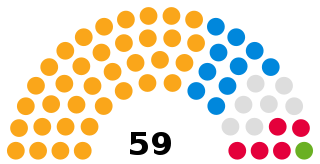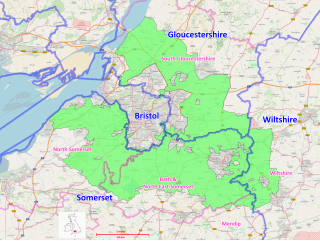
South West England, or the South West of England, is one of nine official regions of England. It consists of the counties of Bristol, Cornwall, Dorset, Devon, Gloucestershire, Somerset and Wiltshire. Cities and large towns in the region include Bath, Bristol, Bournemouth, Cheltenham, Exeter, Gloucester, Plymouth and Swindon. It is geographically the largest of the nine regions of England covering 9,200 square miles (23,800 km2), but the third-least populous, with approximately five million residents.

Avon was a non-metropolitan and ceremonial county in the west of England that existed between 1974 and 1996. The county was named after the River Avon, which flows through the area. It was formed from the county boroughs of Bristol and Bath, together with parts of the administrative counties of Gloucestershire and Somerset.

Bradley Stoke is a town in South Gloucestershire, England, situated 6 miles northeast of Bristol, It is near the Severn Estuary of the Bristol Channel, which is an extension of the North Atlantic Ocean, separating South Wales from South West England. Bradley Stoke is bordered by three motorways; the M5 to the north, the M4 to the east and the M32 to the south.

Keynsham is a town and civil parish located between Bristol and Bath in Somerset, England. It has a population of 19,000. It was listed in the Domesday Book as Cainesham, which is believed to mean the home of Saint Keyne.

Midsomer Norton is a town near the Mendip Hills in Bath and North East Somerset, England, 10 miles (16 km) south-west of Bath, 10 miles (16 km) north-east of Wells, 10 miles (16 km) north-west of Frome, 12 miles (19 km) west of Trowbridge and 16 miles (26 km) south-east of Bristol. It has a population of around 13,000. Along with Radstock and Westfield it used to be part of the conurbation and large civil parish of Norton Radstock, but is now a town council in its own right. It is also part of the unitary authority of Bath and North East Somerset.

Combe Down is a village on the outskirts of Bath, England in the Bath and North East Somerset unitary authority within the ceremonial county of Somerset.

Chilcompton is a village and civil parish in Somerset, England, situated in the Mendip Hills two miles south of Midsomer Norton and 3.0 miles south-west of Westfield. It is situated on the B3139 road between Radstock and Wells, close to the A37.

Twerton is a suburb of the city of Bath, Somerset, England, situated to the west of the city, and home to the city's football club, Bath City.

Newton St Loe is a small Somerset village and civil parish located close to the villages of Corston and Stanton Prior, between Bath and Bristol in England. The majority of the village is owned by the Duchy of Cornwall. The parish has a population of 681.

West of England is a combined authority area in South West England. It is made up of the Bristol, South Gloucestershire, and Bath and North East Somerset unitary authorities. The combined authority is led by the Mayor of the West of England Dan Norris.

Bath and North East Somerset Council is the local council for the district of Bath and North East Somerset in Somerset, England.

The Recreation Ground is a large open space in the centre of Bath, England, next to the River Avon, which is available to be used by permission from the Recreation Ground Trust for recreational purposes by the public at large but particularly the people of Bath and surrounding areas.

Stockwood is a residential area and council ward in south Bristol, between Whitchurch and Brislington, and west of the Somerset town of Keynsham.

MetroWest, formerly known as the Greater Bristol Metro, is a project to improve the rail services in Bristol, England, and the surrounding region. It was first proposed at First Great Western's Stakeholder Event in March 2008. The aim of the project is to develop half-hourly services through central Bristol which will also serve the surrounding West of England region. Transport campaigning groups Friends of Suburban Bristol Railways (FoSBR) and Transport for Greater Bristol are actively supporting the proposal, as are the three unitary authorities under the West of England Combined Authority and North Somerset Council.
Healthcare in Somerset, England was the responsibility of three clinical commissioning groups (CCGs) until July 2022. These covered the ceremonial county of Somerset, which comprises the areas governed by Somerset County Council and the unitary authorities of North Somerset and Bath and North East Somerset.
Healthcare in Wiltshire, England, is the responsibility of the integrated care board (ICB) for Bath and North East Somerset, Swindon and Wiltshire.

The West of England Combined Authority (WECA) is a combined authority within the West of England area, consisting of the local authorities of Bristol, South Gloucestershire, and Bath and North East Somerset. The body has its headquarters in the Redcliffe area of Bristol, and is led by the Mayor of the West of England. The most recent election for this post took place on 6 May 2021, when the Labour candidate Dan Norris was elected on a turnout of 36%.

The 2021 West of England mayoral election was held on 6 May 2021 to elect the mayor of the West of England, on the same day as other local elections across the country. It was the second election for the role. The mayor was elected by the supplementary vote system.
South Bristol is the part of Bristol, England south of the Bristol Avon. It is almost entirely made up of the areas of the city historically in Somerset, and since the abolition of the county Avon, consists of the southern suburbs in the county of Bristol. Definitions sometimes also include areas of North Somerset, including Long Ashton, Nailsea and Backwell.

The Avon Green Belt, also known as the Bristol and Bath Green Belt, is a non-statutory green belt environmental and planning policy that regulates urban expansion and development in the countryside surrounding the cities of Bristol and Bath in the South West region of England. It covers areas in Bristol, South Gloucestershire, North Somerset, Bath and North East Somerset, Mendip, and Wiltshire. Essentially, the function of the green belt is to limit urban sprawl and maintain the open character of areas around the Bristol and Bath built up areas, and nearby towns and villages. The policy is implemented by local planning authorities on the basis of guidance from central government.

















